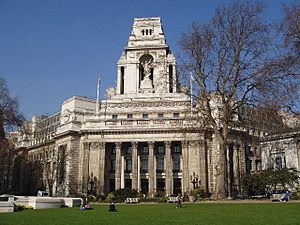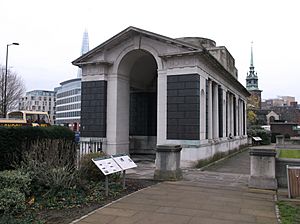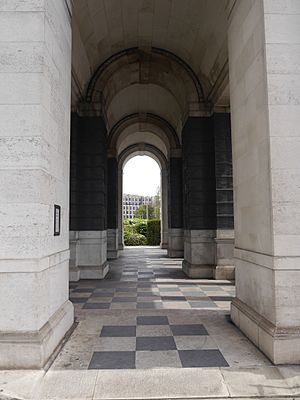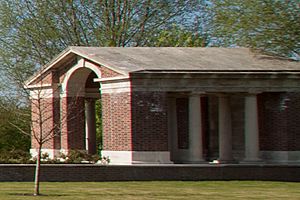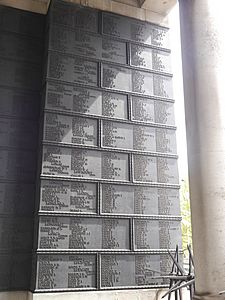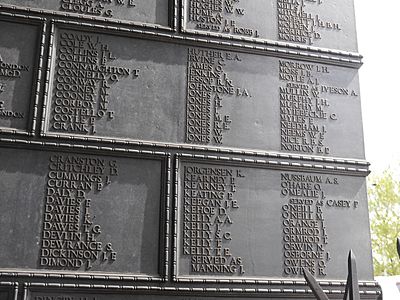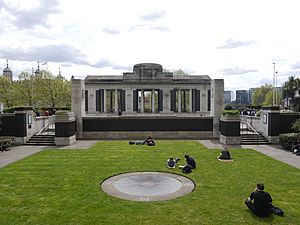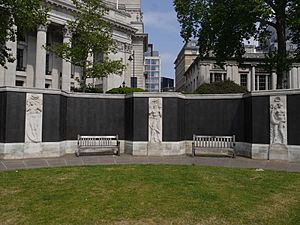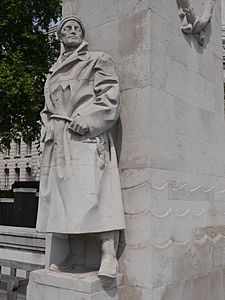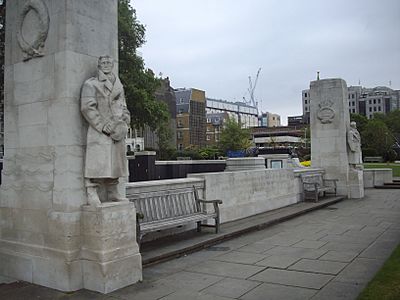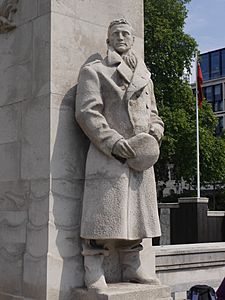Tower Hill Memorial facts for kids
Quick facts for kids Tower Hill Memorial |
|
|---|---|
| Commonwealth War Graves Commission | |
| For men and women of the Merchant Navy and fishing fleets who died in both World Wars and who have no known grave | |
| Unveiled | 12 December 1928 5 November 1955 |
| Location | 51°30′35″N 0°04′40″W / 51.5097°N 0.0777°W Trinity Square Gardens
London, EC3 |
| Designed by | Sir Edwin Lutyens Sir Edward Maufe |
| Commemorated | 36,087 |
|
First World War
TO THE GLORY OF GOD AND TO THE HONOUR OF TWELVE THOUSAND OF THE MERCHANT NAVY AND FISHING FLEETS WHO HAVE NO GRAVE BUT THE SEA Second World War THE TWENTY FOUR THOUSAND OF THE MERCHANT NAVY AND FISHING FLEETS WHOSE NAMES ARE HONOURED ON THE WALLS OF THIS GARDEN GAVE THEIR LIVES FOR THEIR COUNTRY AND HAVE NO GRAVE BUT THE SEA |
|
| Statistics source: Cemetery details. Commonwealth War Graves Commission. | |
|
Listed Building – Grade I
|
|
| Official name | The Mercantile Marine First World War Memorial |
| Designated | 27 September 1973 |
| Reference no. | 1260087 |
|
Listed Building – Grade II
|
|
| Official name | Merchant Seamen's Memorial |
| Designated | 15 April 1998 |
| Reference no. | 1031597 |
The Tower Hill Memorial is a special place in London, England. It has two main parts. These parts remember civilian merchant sailors and fishermen. They died during the First World War and Second World War. These brave people have no known grave, so their names are listed here.
The first part, called the Mercantile Marine War Memorial, was finished in 1928. It was designed by Sir Edwin Lutyens. The second part, the Merchant Seamen's Memorial, was finished in 1955. It was designed by Sir Edward Maufe. In 2005, a third smaller memorial was added. It remembers sailors who died in the 1982 Falklands War.
Contents
What is the Tower Hill Memorial?
The Tower Hill Memorial is looked after by the Commonwealth War Graves Commission. This group makes sure that all soldiers, sailors, and airmen who died in the World Wars are remembered. This includes those who served in the Merchant Navy.
During the First World War, many merchant ships were sunk. Over 17,000 lives were lost. About 3,300 British ships were destroyed by enemy action. Because of these huge losses, a memorial was needed.
Remembering World War I Sailors
After the First World War, many memorials were built. The Imperial War Graves Commission (now the Commonwealth War Graves Commission) was in charge of remembering all British Empire casualties. They wanted everyone to be remembered equally. If a body could not be found, the person's name was put on a large memorial like Tower Hill.
Merchant ships were very important during the war. They brought food and supplies to Britain. German submarines often attacked these ships. By the end of the war, over 3,300 British merchant ships were sunk. More than 17,000 sailors died.
How the First Memorial Was Built
The Commission wanted to build a monument, not a building like a home for sailors. They first planned to put the memorial by the River Thames. The architect, Sir Edwin Lutyens, designed a huge arch. But this idea was rejected.
A new location was chosen at Trinity Square Gardens on Tower Hill. This area has a long history with the sea. It is near the Port of London Authority building and Trinity House. This site was government land, so a special law was needed to build there.
The memorial was opened by Queen Mary on 12 December 1928. It was her first time speaking on the radio. Even though it was raining, many people came to the ceremony.
What the First Memorial Looks Like
The First World War memorial is made of light-colored stone. It looks like a long, open hallway with columns. It is about 21.5 meters long and 10 meters tall. The walls inside have bronze panels. These panels list the names of the missing sailors. The names are organized by ship.
The main message on the memorial says: "TO THE GLORY OF GOD AND TO THE HONOUR OF TWELVE THOUSAND OF THE MERCHANT NAVY AND FISHING FLEETS WHO HAVE NO GRAVE BUT THE SEA". The floor inside has a black and white checkerboard pattern.
One of the biggest losses remembered here is from the sinking of the RMS Lusitania in 1915. More than 350 British crew members from that ship are on this memorial. In total, about 12,000 names are listed here.
- Plaques bearing the names of the dead from the RMS Lusitania, the largest single loss of life to be commemorated on the Mercantile Marine Memorial
Remembering World War II Sailors
During the Second World War, even more ships were sunk. About 4,786 ships were lost, and 32,000 lives. Almost 24,000 of these names are on the Tower Hill memorial.
After this war, people did not want many new large memorials. Instead, many existing memorials were made bigger. The Commission decided to add to the Tower Hill site.
How the Second Memorial Was Built
The architect for the second memorial was Edward Maufe. He was asked to design something that would fit well with Lutyens' first memorial. Maufe first suggested making Lutyens' structure longer, but this was not approved.
His next idea was a sunken garden, which was accepted. Another special law was passed in 1952 to allow this. Work started in 1952 and finished in 1955. The garden's depth had to be changed because of a London Underground tunnel nearby.
The memorial lists 23,765 men from British merchant ships and fishing fleets. These are people who died at sea because of enemy action. Queen Elizabeth II opened the new memorial on 5 November 1955. After the ceremony, 16,000 family members laid flowers around the memorial.
What the Second Memorial Looks Like
The Second World War memorial is a half-circle sunken garden. It is located behind the first memorial. The idea of a sunken garden was popular after the war. It offered a quiet place for people to remember and reflect.
- Sculptures at the entrance to the sunken garden
At the entrance, there are two tall stone pillars. They stand next to a low wall. This wall has the years of the war (1939–1945) and the memorial's dedication. The dedication says: "THE TWENTY FOUR THOUSAND OF THE MERCHANT NAVY AND FISHING FLEETS WHOSE NAMES ARE HONOURED ON THE WALLS OF THIS GARDEN GAVE THEIR LIVES FOR THEIR COUNTRY AND HAVE NO GRAVE BUT THE SEA".
Each pillar has a large statue. One is a Merchant Navy sailor, and the other is an officer. Steps lead down to the sunken garden. The garden walls are 8 feet high and made of the same stone as the first memorial. These walls have 132 bronze panels with the names of the missing.
Around the curved part of the garden are seven sculptures. These sculptures represent the Seven Seas. They were made by Charles Wheeler. In the middle of the grassy garden is a bronze compass sculpture. The Red Ensign, the flag of British civilian ships, flies over the site.
- Wheeler's allegorical sculptures representing the Seven Seas
More Recent History
The Tower Hill Memorial remembers 36,087 sailors from both World Wars. Only those who have no known grave are listed here. Others are remembered in different places.
Since 2000, September 3rd is celebrated as Merchant Navy Day. A special service is held at the Tower Hill Memorial around this date.
In 2005, another memorial was added. It is for the Merchant Navy and Royal Fleet Auxiliary sailors who died in the 1982 Falklands War. This memorial is a 3-meter bronze sundial on a granite base. It has a large bronze anchor in the middle. Bronze plaques around the base list the names of the 17 dead. One plaque says: "IN MEMORY OF THOSE MERCHANT SEAFARERS WHO GAVE THEIR LIVES TO SECURE THE FREEDOM OF THE FALKLAND ISLANDS 1982".
The first memorial (from World War I) is a Grade I listed building. This means it is a very important historic building. The second memorial (from World War II) is a Grade II* listed building. This also means it is very important. The Falklands War memorial is not a listed building.




